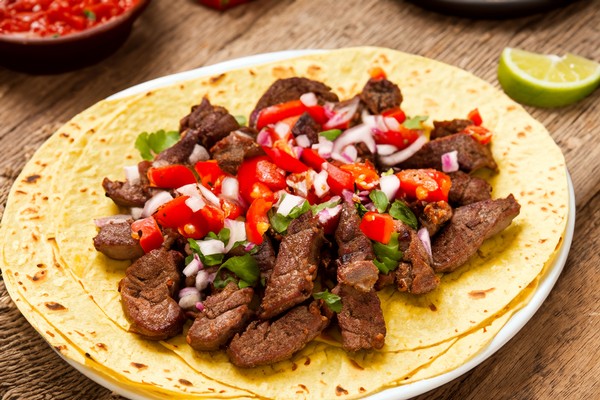Steak Fajitas

Skirt steak is the traditional cut used for fajitas. It used to be inexpensive, but now it's not so cheap; oftentimes flank steak costs less. Either will be a good choice.
Marthinus StrydomThe Story
Steak fajitas, now a staple in Tex-Mex cuisine, originated from humble beginnings and evolved through a fascinating blend of cultural and culinary practices. The roots of this dish trace back to the northern regions of Mexico, where ranching was prevalent, and the traditional practice of grilling meat was common among the local cowboys, known as vaqueros. These vaqueros often received skirt steak, a tough cut of beef, as part of their compensation. They mastered the art of cooking this cut over an open fire, a technique that tenderized the meat and enhanced its flavor. The grilled meat was then typically served in a flour or corn tortilla, providing a simple, hearty meal that was both practical and satisfying.
The journey of steak fajitas from a cowboy's staple to a popular restaurant dish is a testament to the rich cultural exchange along the Texas-Mexico border. The term "fajita," derived from the Spanish word "faja," meaning "strip," aptly describes the cut of beef used. The dish began gaining commercial popularity in the 1960s, notably with Sonny Falcon, who is credited with operating the first commercial fajita taco stand in Texas in 1969. Another significant contribution came from George Weidmann, who introduced fajitas at the Hyatt Regency in Austin in 1982, thereby popularizing the dish in American mainstream cuisine. Today, steak fajitas have transcended their regional roots, enjoyed worldwide in various forms. They are typically accompanied by grilled onions and bell peppers and served with a range of condiments such as sour cream, guacamole, salsa, and cheese. The evolution of steak fajitas from a cowboy's nourishment to a beloved international dish showcases the dynamism of Tex-Mex cuisine and its ability to adapt and appeal to a global palate.

Subscripe to my Facebook page.
Subscripe to my Youtube channel.
© All recipes are copyright protected by TheCultureCook.com unless the recipe was adapated from another source. All recipes are uniquely crafted and adapted by TheCultureCook.com. Copyright of some or all of the text reside with the original author.
Ingredients
Method
Step 1
Combine 2 teaspoons ground cumin, the chile powder and 1 teaspoon salt. With a sharp knife, cut shallow crosshatched incisions across top and bottom surfaces of steak. Rub spice mix all over surface of steak. (It's best to wear gloves as the chile powder is hot.) Place steak in a resealable freezer bag.
Step 2
In a small bowl, whisk together lime juice and zest, ¼ cup olive oil, the Worcestershire sauce and half the garlic. Reserve 2 tablespoons of the marinade and pour the rest into the bag with steak. Seal and move steak around in bag to coat thoroughly. Place on a sheet pan and refrigerate for at least 4 hours and up to 24 hours. Massage bag periodically to redistribute marinade. Refrigerate reserved marinade if cooking the next day.
Step 3
Heat 2 tablespoons olive oil in a large, heavy skillet over medium-high heat. Add onions and cook, stirring, until they soften and begin to color, 4 to 5 minutes. Stir in bell peppers and chile. Cook, stirring, until peppers begin to soften, about 3 minutes.
Step 4
Lower heat to medium, add remaining garlic and cumin, and salt to taste. Cook, stirring often, until peppers are nicely seared, softened and beginning to caramelize, 5 to 8 minutes.
Step 5
Pour in reserved 2 tablespoons marinade and scrape bottom of pan with a wooden spoon to deglaze. Stir in half the cilantro. Taste and adjust seasoning. Remove from heat but keep warm.
Step 6
Wrap tortillas in foil and warm in a low oven, or wrap in a towel and warm in a steamer or in the microwave.
Step 7
Heat a large cast iron skillet over medium-high heat, or prepare a medium-hot grill. Remove meat from marinade and discard marinade. Pat meat dry with paper towels. If using a skillet, heat remaining 1 tablespoon oil in skillet. (If your skillet is not large enough for the steak, cut it in half and cook in batches.) Cook for 3 to 4 minutes per side. Meat should be medium rare. Remove to a cutting board, cover with foil and let sit for 10 minutes. Cut across the grain into ½- to ¾-inch wide strips.
Step 8
Arrange lettuce on a platter, then place steak next to lettuce. Tip juices from cutting board over meat and sprinkle with remaining cilantro. Serve vegetables on the same platter or separately, along with warm tortillas, salsa and crumbled queso fresco.
